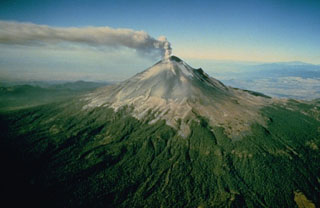Report on Popocatepetl (Mexico) — June 1994
Bulletin of the Global Volcanism Network, vol. 19, no. 6 (June 1994)
Managing Editor: Richard Wunderman.
Popocatepetl (Mexico) Seismicity increases in April and May, but declines in June
Please cite this report as:
Global Volcanism Program, 1994. Report on Popocatepetl (Mexico) (Wunderman, R., ed.). Bulletin of the Global Volcanism Network, 19:6. Smithsonian Institution. https://doi.org/10.5479/si.GVP.BGVN199406-341090
Popocatepetl
Mexico
19.023°N, 98.622°W; summit elev. 5393 m
All times are local (unless otherwise noted)
Seismicity began increasing in March, with 99 B-type events, compared to December 1993-February 1994 when 62 B-type events were recorded each month (19:1, 2, & 4). This increase continued in April and May, with 164 and 295 B-type events, respectively (figure 3). However, after a peak of 16 events on 24 May, B-type seismicity began decreasing again through June (169 events). In general, when B-type events showed sharp decreases, A-type and AB-type events appeared (1-2 events/day). Throughout May and June only 7 A-type and 5 AB-type events were detected.
Geological Summary. Volcán Popocatépetl, whose name is the Aztec word for smoking mountain, rises 70 km SE of Mexico City to form North America's 2nd-highest volcano. The glacier-clad stratovolcano contains a steep-walled, 400 x 600 m wide crater. The generally symmetrical volcano is modified by the sharp-peaked Ventorrillo on the NW, a remnant of an earlier volcano. At least three previous major cones were destroyed by gravitational failure during the Pleistocene, producing massive debris-avalanche deposits covering broad areas to the south. The modern volcano was constructed south of the late-Pleistocene to Holocene El Fraile cone. Three major Plinian eruptions, the most recent of which took place about 800 CE, have occurred since the mid-Holocene, accompanied by pyroclastic flows and voluminous lahars that swept basins below the volcano. Frequent historical eruptions, first recorded in Aztec codices, have occurred since Pre-Columbian time.
Information Contacts: Guillermo González-Pomposo and Carlos Valdés-González, Departamento de Sismología y Volcanología, Instituto de Geofísica, UNAM.


